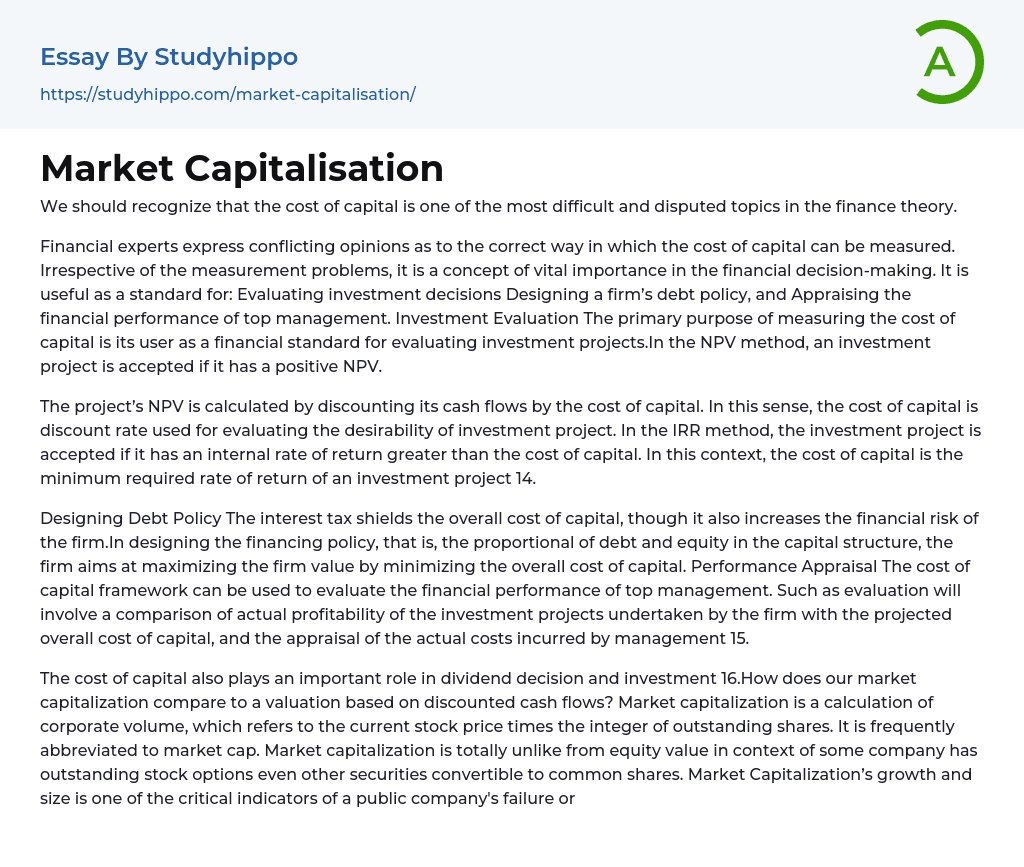Assessing the cost of capital is a complex and contentious concept in finance theory, with varying viewpoints among experts. However, it holds significant importance in financial decision-making. It acts as a standard for appraising investments, establishing debt strategies, and evaluating the financial performance of senior management.
Investment evaluation involves assessing investment projects by measuring the cost of capital, which serves as a financial standard. The NPV method evaluates an investment project based on its positive NPV, calculated by discounting cash flows using the cost of capital as the discount rate. The cost of capital is used to determine the attractiveness of an investment project. On the other hand, the IRR method accepts an investment project if its internal rate of return exceeds the cost of capital. In this scenario, the cost of capital represents the minimum required rate of return for an
...investment project.
When developing a debt policy, a company considers interest tax shields and their impact on overall cost of capital, which also increases financial risk. The objective is to maximize value by minimizing overall cost of capital through determining the appropriate mix of debt and equity in its capital structure.
The cost of capital framework can be used to evaluate the financial performance of top management. This evaluation involves comparing the actual profitability of the firm's investment projects with the projected overall cost of capital, as well as assessing the incurred costs by management (15). Additionally, dividend decisions and investments are significantly influenced by the cost of capital (16).
How does our market capitalization compare to a valuation based on discounted cash flows? Market capitalization is determined by multiplying the current stock price by the intege
value of outstanding shares. This calculation, commonly known as market cap, is separate from equity value. The distinction arises when a company has outstanding stock options or other securities that can be converted into common shares.
Market capitalization is an important indicator of a public company's performance, taking into account its growth and size. This measurement can be influenced by acquisitions, divestitures, and stock repurchases. To calculate market capitalization, one must multiply the current share price by the number of common shares. Additionally, it represents the total funds used to support a company's balance sheet and is calculated as market capitalization plus debt and preferred stock.
The stock price of a company determines its market capitalization, which may not always accurately represent the actual value of the firm. This discrepancy can occur due to varying investor expectations for the future. As a result, the market capitalization often surpasses the "book value" of the company, leading to higher market prices compared to earnings. The reason behind this is that anticipated future growth contributes to adding value. It should be noted that the total number of shares available for trading on the open market might be lower than the overall number of shares due to insiders and the company itself holding onto some portion of "free float" shares.
Furthermore, the float of a stock can be significantly lower than its total number of shares because large institutional investors, who do not trade frequently, own a portion. Consequently, only a small percentage of shares are usually exchanged daily. The valuation of securities can be achieved through discounted cash flow (DCF) analysis, which involves forecasting various factors. In this study, I employ
simulation to assess how different variables affect the projected stock price. The primary objective of discounted cash flow modeling is to establish meaningful benchmarks that can justify a company's long-term operational performance.
The market benchmark is typically earnings or earnings growth. Additionally, various assumptions about the primary forecast time horizon and the choice of a 20-time horizon are explored. Security analysts use different methods to determine stock recommendations, with discounted free cash flow (DCF) analysis being considered the best method. However, this analysis requires the analyst to forecast numerous variables.
Due to the model's complexity, many people choose simplified P/E models and forecasts for earnings growth. This paper demonstrates an example of using simulation to identify the most significant variables 21.
- Money essays
- Financial Accounting essays
- Market Segmentation essays
- Supply And Demand essays
- Purchasing essays
- Forecasting essays
- Legacy essays
- Bank essays
- Corporate Finance essays
- Financial News essays
- Financial Ratios essays
- Financial Services essays
- Free Market essays
- Shareholder essays
- Personal finance essays
- Equity essays
- Financial Crisis essays
- Banking essays
- Credit Card essays
- Currency essays
- Debt essays
- Gold essays
- Loan essays
- Enron Scandal essays
- Foreign Exchange Market essays
- Investment essays
- Venture Capital essays
- Stock Market essays
- Retirement essays
- Donation essays
- Net Present Value essays
- Income Statement essays
- Commercial Bank essays
- Debit Card essays
- Deposit Account essays
- Subprime Lending essays
- Perfect Competition essays
- Underwriting essays
- Synergy essays
- Valuation essays
- Investing essays
- Asset essays
- Depreciation essays
- Discounted Cash Flow essays
- Foreign Direct Investment essays
- Funds essays
- Internal Rate Of Return essays
- Revenue essays
- Day Trading essays
- Futures Trading essays




